NIPCC Report Website
Reference:
Christy, J.R., Herman, B., Pielke Sr., R., Klotzbach, P., McNider, R.T., Hnilo, J.J., Spencer, R.W., Chase, T., and Douglass, D. 2010. What do observational datasets say about modeled troposphere temperature trends since 1979? Remote Sensing 2: 2148-2169. Testing of climate model results is an important but difficult problem. One of the key model results is the presence of a tropical troposphere “hotspot” in which the troposphere warms faster than the surface under conditions of enhanced greenhouse gas forcing. Previous studies have produced disagreement over whether data were consistent with models on this question. In this study, the authors made several advances by doing the following: 1) enhancing the data for surface trends, 2) extending the data to a 31-year length, 3) evaluating the wind-based temperature estimates, and 4) clarifying the meaning of “best estimate” multi-data warming trends from data and models.
Two prior studies had derived tropospheric temperature trends from the Thermal Wind Equation (TWE)—which uses radiosonde measurements of wind speed to calculate temperature—on the theoretical basis that warmer air should move faster than cooler air. They found that there were biases in the data for this type of calculation. For example, particularly for older radiosonde observations, on days when the upper wind was stronger, the balloons would tend to blow out of receiver range. This created a bias by causing missing data for high winds for older observations, leading to a spurious warm trend over time. Overall, the TWE-based trends were three times greater than trends derived from all other types of data. In addition, they did not agree with other wind data, and were also based on much sparser data. This type of data was therefore not used in the authors’ analysis, which also identified a small warm bias in the RSS satellite data that was explained by Christy and his colleagues.
The next innovation was to use the Scaling Ratio (SR), which is the ratio of atmospheric temperature trend to surface temperature trend. The SR attempts to factor out the effect of the lack of actual (historic) El Nino’s or other oscillations in climate model runs, and different such simulated events in different computer runs.
The nine researchers found that the SR for real-world data was 0.8 plus/minus 0.3, whereas the model simulations had a SR of 1.38 plus/minus 0.08 (a significant difference). That is, the data show a lower rate of warming for the lower troposphere than for the surface (though not statisically different), whereas the models show amplification, as theorized. In fact, the SR value for the middle troposphere data was 0.4, which is even more different from the model predictions. Only the SR for RSS data, which has the documented warming bias noted above, overlaps with any model SR results.
This study thus suggests that current state-of-the-art climate models have something fundamentally wrong with how they represent earth’s atmosphere.
See post here.
By Alan Caruba
In the Greek myth about Cassandra, she could foresee the future, but no one believed her warnings. Her name is believed to be derived from the words for beauty and the sun.
Any number of solar scientists and others are warning that the Earth is on the brink of a new Ice Age at worst, a mini ice age at best. Dr. Achim Brauer of the German Research Center for Geosciences in Potsdam has concluded that the next Ice Age will come on so swiftly that in barely a year much of the northern hemisphere will be incased in ice and snow.
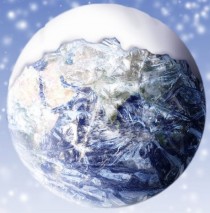
The last Ice Age lasted 100,000 years. The Little Ice Age from around 1300 to 1850 lasted long enough to transform European society and have a profound affect on the histories of America and France. In England, they went from growing grapes to skating on a completely frozen Thames.
All the signs are in place and throughout the northern hemisphere nations, their leaders prattle on about global warming, clean energy, endangered species, and all the other environmental foolishness without once casting an eye toward the source of all climate on Earth, the Sun!
While the warmists were trying to stir up hysteria over an Earth whose temperature was suppose to rise dramatically, Nature had other plans. For the past decade the magnetic field that triggers sunspots, magnetic storms on the face of the Sun, has been steadily declining and, with it, so has the overall temperature of planet Earth.
No matter what august figure blathers about climate change these days, they are either an ignorant fool or a charlatan seeking to enrich himself by one scheme or another. The situation for the warmists has become so dire that even the science advisor to the President, Dr. John Holdren, wants to change the terminology of global warming to “global climate disruption”, admitting the former is “a dangerous misnomer.”
It’s worse than that. It is a huge fraud, a hoax, a crime intended to deceive millions.
Okay, let’s all forget the millions of words and millions of dollars spent to convince us that “global warming” was such a sure thing that any scientist or reasonably intelligent person disputing it was labeled a denier, but the truth was that the data generated by the computer models to justify the claim was rigged!
My friend, Robert Felix, author of “Not by Fire, but by Ice”, and editor of IceAgeNow.com, probably knows more about ice ages than anyone on the planet. In his book, he says “Ice ages begin and end abruptly every 11,500 years.” Guess what? We are now 11,500 years since the last Ice Age ended!
While idiots run about claiming that humans actually have any affect whatever on the climate and thus the fate of the Earth, Felix reminds us that “the Earth is a violent and dangerous place to live. We’re beginning to realize that mass extinctions have been the rule, rather than the exception, for the 3.5 billion years that life has existed on this planet.”
On June 14 in an article published in the New Scientist by Stuart Clark, he raised the question of why and where the sunspots of gone. Noting that they ebb and flow in cycles lasting about eleven years, Stuart said, “But for the last two years, the sunspots have mostly been missing. Their absence, the most prolonged in nearly 100 years, has taken even seasoned sun watchers by surprise.”
Not everyone, though. Felix believes we are on the cusp of the next Ice Age and, frankly, so do I. “This is not the calm before the storm,” says Felix. “This is the storm.”
If we’re lucky, it may just be a new Little Ice Age, but it could be a new Ice Age and, if that’s the case, a lot of life on planet Earth is going to be severely disrupted for a very long, long time.
Even a brief ice age of several hundred years will increase the demand for the generation of energy to keep us warm. All of a sudden everyone including the environmentalist liars will be crying out for more coal, more oil, and more natural gas.
Cassandra is saying bundle up! See post here. Meanwhile:
-------------
Romm Forecasts 4C Warming From 2000-2080
By Steve Goddard, Real Science
Romm notes here “The rate of human-driven warming in the last century has exceeded the rate of the underlying natural trend by more than a factor of 10, possibly much more. And warming this century on our current path of unrestricted greenhouse gas emissions is projected to cause a rate of warming that is another factor of 5 or more greater than that of the last century. We are punching the climate beast - and she ain’t happy about it!”
That works out to 0.5C warming per decade, starting in the year 2000. So how is he doing so far? I overlaid HadCrut (pink) on his graph at the same scale. The thin red line shows where we are “supposed to be” in 2010. Way off the mark.
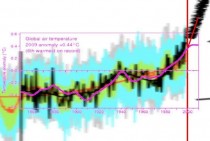
Instead of warming 0.5C this past decade, temperatures barely warmed at all. Even more damning, half of the 20th century warming occurred with CO2 levels less than 320 ppm - barely above pre-industrial values.
The warming from 1910 to 1940 was just as great as the warming from 1970 to 2000, yet it can hardly be blamed on CO2. And the graph since 2000 is not even remotely following his forecast. See post here.
By Steven Goddard, Watts Up with That
"There are claims coming from some communities that the Arctic sea ice is recovering, is getting thicker again,” Mark Serreze, director of the Colorado-based centre, told Postmedia News on Wednesday. “That’s simply not the case. It’s continuing down in a death spiral.”
US Navy PIPS2 maps show that the area of Arctic ice greater than 2 metres thick has increased by about 50% since the same date in 2008. The blink comparator here removes all ice reported as less than two metres thick.

Light green shows expansion of 2 metre thick ice since 2008

Original PIPS2 images are shown below.
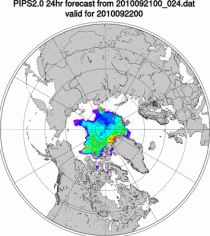
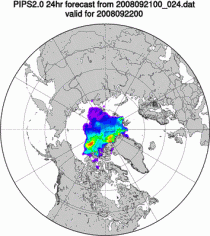
See full post here.
By Andrew Gilligan
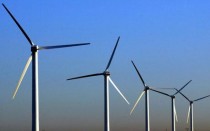
Even as parts of the British Government continue to blow hard for wind, other countries seem to be cooling on the idea Photo: PA
To green campaigners, it is windfarm heaven, generating a claimed fifth of its power from wind and praised by British ministers as the model to follow. But amid a growing public backlash, Denmark, the world’s most windfarm-intensive country, is turning against the turbines.
Last month, unnoticed in the UK, Denmark’s giant state-owned power company, Dong Energy, announced that it would abandon future onshore wind farms in the country. “Every time we were building onshore, the public reacts in a negative way and we had a lot of criticism from neighbours,” said a spokesman for the company. “Now we are putting all our efforts into offshore windfarms.”
Even as parts of the British Government continues to blow hard for wind, other countries seem to be cooling on the idea. This summer, France brought in new restrictions on wind power which will, according to the French wind lobby, jeopardise more than a quarter of the country’s planned windfarm projects.
According to the latest Wind Turbine Price Index, produced by Bloomberg New Energy Finance, world prices for new wind turbines are down by 15 per cent on their 2008 peak amid a sharp slump in European and global demand. William Young, manager of Bloomberg’s Wind Insight Service, says: “Expectations for turbine prices have never been so low, and the current market oversupply will continue for quite a while longer.”
But it is in Denmark, the great windfarm pioneer, where some of the most interesting changes are taking shape. In 1980, the Danish government was Europe’s first to bring in large-scale subsidies - on which, just as in Britain, the wind industry depends.
The results have been dramatic. According to the Danish Wind Energy Association, there are more than four thousand onshore turbines - two-thirds more than Britain - in a country a fifth the size. Nowhere else has more turbines per head, and Denmark is also a global centre of wind turbine manufacturing - with Vestas, the world’s leading turbine firm, based in the country.
Unfortunately, Danish electricity bills have been almost as dramatically affected as the Danish landscape. Thanks in part to the windfarm subsidies, Danes pay some of Europe’s highest energy tariffs - on average, more than twice those in Britain. Under public pressure, Denmark’s ruling Left Party is curbing the handouts to the wind industry.
“Since 2005 alone, 5.1 billion kroner [621 million pounds] has been paid to the wind turbine owners. That cost has been borne by businesses and private consumers,” says the party’s environment spokesman, Lars Christian Lilleholt. “It seems to have become a political fashion to say that there should be more support for wind. But we have to look at other renewables. We cannot go on with wind power only.”
The subsidy cuts are almost certainly the main reason behind Dong’s move out of onshore wind. But public anger is real enough, too. Until recently, there was relatively little opposition to the windmills. But now a threshold appears to have been crossed. Earlier this year, a new national anti-wind body, Neighbours of Large Wind Turbines, was created. More than 40 civic groups have become members.
“People are fed up with having their property devalued and sleep ruined by noise from large wind turbines,” says the association’s president, Boye Jensen Odsherred. “We receive constant calls from civic groups that want to join.”
In one typical battle, in the central city of Svendborg, the local council set height and number limits on turbines under heavy pressure from locals. “The violent protests and the uncertainty about low-frequency noise means that right now we will not expose our citizens to large windmills,” said the deputy mayor, Lars Erik Hornemann.
There has also been growing scrutiny of the wind industry’s macro claims. Though wind may indeed generate an amount of electricity equal to about a fifth of Danes’ needs, most of that electricity cannot actually be used in Denmark.
Except with hydropower, electricity cannot be stored in large quantities. The power companies have to generate it at the moment you need to use it. But wind’s key disadvantage - in Denmark, as elsewhere – is its unpredictability and uncontrollability. Most of the time, the wind does not blow at the right speeds to generate electricity. And even when it does, that is often at times when little electricity is needed - in the middle of the night, for instance.
So most of the wind electricity Denmark generates has to be exported, through interconnection cables - to Germany, to balance the fluctuations in that country’s own wind carpet, or to Sweden and Norway, whose entire power system is hydroelectric, and where it can be stored. (The Swedes and Norwegians use it themselves - or sell it back, at a profit, to the Danes. If they use it themselves, there is, of course, no saving whatever of C02 - because all Norway and Sweden’s domestically-generated hydropower is carbon-neutral anyway.)
“I would interpret the [export] data as showing that the Danes rely on their fossil-fuel plants for their everyday needs,” says John Constable, research director for the London-based Renewable Energy Foundation, which has commissioned detailed research on the Danish experience. “They don’t get 20 per cent of their electricity from wind. The truth is that a much larger unit, consisting of Denmark and Germany, has managed to get about 7 per cent - and that only because of a fortuitous link with Norwegian and Swedish hydropower.”
Britain, meanwhile, almost certainly could not manage even that. “Our system is totally different,” says Constable. “We are an island grid.
We have virtually no interconnectors with other countries, only a very limited amount of hydro, and the British Government simply doesn’t know how to integrate the very large fleets of wind turbines that they are blithely introducing. It’s a leap in the dark.”
Britain will almost certainly, in fact, end up having to build as many new fossil-fuelled power stations as it would have done without windfarms, to provide covering power for the fluctuations of the wind.
Apparently oblivious to all this, the Government’s climate change watchdog, the Committee on Climate Change, continues to praise Denmark’s example and only last week demanded the building of 10,000 more onshore wind turbines to help meet a Whitehall target that 30 per cent of Britain’s electricity should be generated from renewables by the end of the decade. This goal (the current figure is 4 per cent) is politely described as “optimistic” by the National Audit Office; privately, most observers view it as total fantasy.
Interestingly, however, Chris Huhne, the previously anti-nuclear, pro-wind Energy Secretary, appears to be undergoing a mood shift.
There is still much government talk of offshore wind, but he has sounded a more emollient note on a new generation of nuclear stations.
“I think there’s an outbreak of realism,” says Constable. “Wind is not a bad technology. It’s just a lot more limited than people thought in the past.” Denmark, of course, was also the place where UN efforts to reach an overarching climate deal collapsed in acrimony last year. The country appears to be developing a habit of puncturing greens’ wilder hopes. Read more here.
UK Telegraph
Prince Charles baffled by ‘extraordinary’ climate change scepticism. The Prince of Wales said he found the views of climate change sceptics ‘’extraordinary’’.
Published: 9:27AM BST 10 Sep 2010
He also made an impassioned plea for the country to adopt greener ways as he gave a breakfast television interview. He warned that living on the planet would be ‘’no fun at all’’ for future generations unless people took action to combat climate change. Charles has spent the week touring eco-projects across the country and emphasised how some local people were taking up the challenge of adopting more sustainable lives.
The heir to the throne’s comments were made in a pre-recorded interview with Adrian Chiles and Christine Bleakley, the hosts of ITV’s new breakfast show Daybreak.
The royal chatted to the presenters in the garden of his London home Clarence House yesterday evening and even showed them his small vegetable garden with its neat rows of lettuces and leeks.
Speaking about his travels around the country to promote his START initiative - which aims to encourage the public to move towards a more sustainable lifestyle - Charles said: ‘’What I’ve been trying to highlight is the fact that so much can be done by communities - it’s a grassroots thing.
‘’Frequently people have taken it onto themselves to try and do all these things because they get frustrated I think, and they also realise there is a huge challenge that we’re facing.
‘’And you know (we’re) putting nature’s systems under huge strain and we can’t go on like that if we want to hand over something reasonably worthwhile to our children and grandchildren.’’
Asked by Bleakley what he thought of climate change doubters, the Prince responded: ‘’I find it quite extraordinary, because to me it seems only sensible to take a precautionary approach. There is something going very wrong.
“And I would say to all these sceptics - alright it may be very convenient to believe that somehow all these greenhouse gases we’re pouring into the atmosphere just disappear through holes conveniently into space, it doesn’t work like that.”
Be sure to read the comments. Post and comments here.
By John Croman
MINNEAPOLIS—An environmental group pushing clean energy released a report Wednesday connecting 2010’s bumper crop of extreme weather events to global warming from greenhouse gases. Those include wildfires in the West, drought-driven smog in Russia and historic floods in Pakistan and the U.S.
“We’ve had two once-in-500-years floods in the last 15 years in Iowa,” Ken Bradley of Environment Minnesota told reporters, “As the earth warms up, and as the water evaporates from the ocean and other areas, that is what is increasing the precipitation.”
Bradley released his group’s “Extreme Weather Report” with the help of two heavy hitters in the climate change debate, polar explorer Will Steger and veteran meteorologist Paul Douglas. The press conference took place at WeatherNation, the private forecasting agency headed by Douglas in Excelsior.

The three AGW Amigos
“We are now the center of tornado alley! Tornado alley took a 500-mile deter to the north this year,” Douglas remarked, “We’ve had 145 tornados in Minnesota, twice as many as Oklahoma.” ICECAP NOTE: Eh...It’s called La Nina, Paul
Douglas conceded that one extraordinary year of violent weather does not, in and of itself, add up to an overheated planet doomed by man-made greenhouse gases. But he views 2010 as part of an alarming pattern. True only in the flawed, manipulated global surface station data bases.
“We’ve had 384 consecutive months now where the global temperature has been warmer than the 20th Century average,” he said, “As a meteorologist who studies short-term weather, I defer to the climate scientists, 97 percent of whom believe that something is going on, that this is not a coincidence.”
Steger said he decided to dedicate his life to slowing climate change after repeated treks through the Arctic Circle, where he saw monumental changes in the ice shelves and glaciers first hand. ICECAP NOTE: He would have seen the same 60 years ago and in the 19th century - because the ice changes are cyclical.

Enlarged here.
“In 2007 we had a major breakup of the Arctic Ocean in the summertime,” Steger said, “We lost over 50 percent of this ice. The Arctic Ocean’s is almost larger than Mexico and the United States put together. You have 50 percent of this breaking up.”
He said he believed it would take 30 years for Americans to make the transition away from fossil fuels, but asserts it must done as part of an economic revival.
“I know the solutions to this are economic,” Steger said, “If there wasn’t a solution I think I’d hang it and live in the North Woods the rest of my life.”
The conservative think tank Freedom Foundation of Minnesota reacted sharply to the Extreme Weather Report Wednesday.
“The climate change debate has been hopelessly politicized by organizations like Environment Minnesota that distort science in order to advance a narrow political agenda,” Jonathan Blake said in a statement released to KARE.
“This issue will not be settled, and should not be settled, by agenda-driven activists on either side.”
Bradley said the report will be used to promote regulation of carbon-based pollution on a national level, and the establishment of a minimum solar energy standard in Minnesota. The state already has standards in place for wind power and renewable fuels.
The system of setting a limit on carbon pollution and selling companies the right to exceed that limit, known as “cap and trade,” has generated opposition from those who believe it will drive up the cost of electricity and throttle heavy industries.
Bradley said, however, severe weather is not without cost.
“The flooding in the Midwest alone is tens of billions of dollars for taxpayers, so there’s a financial impact by not doing anything.”
Paul Douglas said he decided to invest in the clean fuels movement himself, when he recently launched “Smart Energy,” a company devoted to accurately forecasting wind trends for those erecting wind turbines. Douglas has always been an entrepreneur - always quick to take advantage of any money making opportunity
Douglas is a former KARE and WCCO personality, who provides services to KARE’s Weather Now digital weather channel 11-2. That was not a factor in KARE’s decision to cover the story. Sure. See post here.
By RUSSELL CONTRERAS - Associated Press Writer
DUBLIN, N.H. - Most of the country will see a colder-than-usual winter while summer and spring will be relatively cool and dry, according to the time-honored, complex calculations of the “Old Farmer’s Almanac.”
The 2011 issue of the almanac, which claims to be the nation’s oldest continuously published periodical, was released Tuesday. It predicts that in the coming months, the Earth will continue to see a “gradual cooling of the atmosphere ... offset by any warming caused by increased greenhouse gases.”
The “Old Farmer’s Almanac” also is forecasting a weak La Nina - a climate phenomenon marked by an unusual cooling of the sea surface in the tropical Pacific Ocean.
The 219-year-old “Old Farmer’s Almanac” and its longtime New England competitor, the Maine-based “Farmer’s Almanac,” still draw droves of fans despite the age of the Internet and mobile phone apps. The books, which use their own “secret formula” to predict weather based on sunspots, planetary positions and other information, are popular at farmers markets and bookstores and have maintained a fan base that sometimes goes back generations in families.

In this Sept. 1, 2010 photo, editor Janice Stillman, left, and editor-in-chief Jud Hale pose in Dublin, N.H., with the 2011 edition of the Old Farmer’s Almanac on top of the lock box Hale says has the secret formula to predict weather. - Jim Cole /AP Photo
Janice Stillman, editor of the almanac, said that means much of the eastern half of the United States will experience lower-than-normal temperatures with less snow while Mid-Atlantic states will see more snowfall than usual. The West will see a mild winter with average precipitation, she said.
Meanwhile, the South will experience a cold and wet summer and the Rockies should see a mild and dry winter, according to the New Hampshire-based “Old Farmer’s Almanac.”
“It’ll be cold. There will be no mistaking winter,” Stillman said. “But it may be a little shorter or we may see some small warm spells in places like the East Coast.”
The 219-year-old “Old Farmer’s Almanac” and its longtime competitor, the Maine-based “Farmers’ Almanac,” still draw droves of fans despite it being the age of the Internet and mobile phone apps. The books, which use secret formulas to predict weather based on sunspots, planetary positions and other information, are popular at farmers markets and bookstores and have maintained a fan base that sometimes spans generations of families.
Both books have a circulation of around 3.2 million and feature a mix of helpful hints, recipes, gardening tips, jokes and inspirational messages. Their websites are full of videos, blogs, podcasts, Twitter accounts and Facebook fan pages.
In general, the almanacs’ weather predictions are similar. The “Farmers’ Almanac” also forecasts a colder- than-normal winter.
“Basically we’re saying it’s going to be an ice cold sandwich,” Managing Editor Sandi Duncan said. “We feel the middle part of the country’s really going to be cold - very, very cold, very, very frigid, with a lot of snow. On the East and West coasts, it’s going to be a little milder.”
But the almanacs’ forecasts are at odds with the National Weather Service’s long-range outlook for the meteorological winter, which runs from December through February. Mike Halpert, deputy director of the NOAA Climate Prediction Center in Camp Springs, Md., said the weather service is calling for warmer-than-normal temperatures across much of the country because of an La Nina weather system that has developed in the tropical Pacific Ocean.
Stillman said, however, she’s confident about the weather predictions in the “Old Farmer’s Almanac” because they tend to be 80 to 85 percent accurate - the same accuracy rate boasted by the Maine almanac. The dueling almanacs have enjoyed a long, mostly friend rivalry that dates back nearly 200 years, said Judson Hale, the semiretired chairman and longtime pitchman for the “Old Farmer’s Almanac.” He said any time one of the almanac gets publicity, it helps the other.
But Hale is quick to say his publication is older and has more history: “We’re the one in the Smithsonian. We’re the one that Abraham Lincoln used in a murder trial. We’re the one George Washington read. We are THE one.”
Still, Hale said, both almanacs survive because they’ve maintained strong relationships with their readers for generations. “I think it’s very comforting for people to see that there’s a constant in this world,” he said. “There’s something that, although brand new every year, isn’t changing. It is the same.” See post here.
By Verity Jones and Tony Brown (Tonyb)
Back in October Tony asked me to help with a big idea. Searching Norwegian climate site Rimfrost (www.rimfrost.no) Tony had found many climate stations all over the world with a cooling trend in temperatures over at least the last thirty years - which is significant in climate terms. You see Tony had a grand vision of a website with blue dots on a map representing these “cooling stations”, where clicking on the dots brought up a graph of the data and the wonderful cooling trend. Would this not persuade people to look again at the notion of worldwide global warming?

Figure 1. Map showing stations on Tony’s “Cooling List” - stations which appear to have a cooling trend (>30 years) to present (data source: www.rimfrost.no Oct-Dec 2009; Earth image source: Dave Pape)
I asked Tony how many stations he had in mind. “Oh two hundred or so...” He suggested breaking it down into bite-sized chunks and sending me sets of ten at a time. I was to compare the data with that on the GISS site and/or those of national met agencies where available to verify the source, and produce graphs to a standard template.
We were concerned that this could be seen as ‘cherrypicking’ nonetheless it was an attractive idea. In many cases it was not just cherrypicking the stations, but also the start dates of each cooling trend. Despite these reservations we decided to go ahead, although ultimately we have not completed the project, partly for these reasons, but also because it is a case where the journey became more important than the destination and it is worth sharing.
The first 10 (Set 1) of Tony’s target stations, which at this point I should say seemed to be a randomly chosen set, were:
Brazil - Curitiba (1885 to 2009) Cooling 1955 to 2009
Canada - Edmonton (1881-2009) Cooling from 1886 to 2009
Chile - Puerto Montt (1951-2009) Cooling from 1955
China - Jiuquan (1934-2009) Cooling all years
Russia - Kandalaska (1913-2009) Cooling 1933-2009
Iceland - Haell (1931-2009) Cooling all years
India - Amritsar (1948-2009) Cooling all years
Morocco - Casablanca (1925-2009) Cooling all years
Adelaide - Australia (1881-2008) Cooling all years
Abilene, Texas - USA (1886-2009) Cooling 1933-2009
The comparisons in many cases were not straightforward. While many matched GISS data, some of the graphs in Rimfrost used unadjusted data, others homogenised data. For some such as Kandalaska, there was a close but not exact match to either GISS data set. The data for Haell was clearly from the Icelandic Met Office, but I could find no match for Edmonton to any GISS series or data from Environment Canada (although having looked at Canadian data further since I am not entirely surprised). The first set took much longer than we had anticipated; however, I drew the graphs to a template and prepared to start on Set 2.
Tony also wanted a ‘spaghetti’ graph for the anomaly data of the first set, and this is where it got most interesting. In fact we were blown away by what the graph looked like. Taking these ten locations from across the globe and superimposing the anomaly data produced a sine wave-like pattern (Figure 2, below, enlarged here) with distinct cooling from the early 1940s to mid-1970s followed by warming to present; for many of the locations the older data was warmer, or at least as warm as present. Now I had seen this before with many individual stations, but it really impressed me to see the pattern matching from such far-flung locations.

Figure 2. “Spaghetti graph” (enlarged here) of anomalies for the ten stations in Set 1
But in the meantime there were other developments. Tony knew I was interested in putting the GHCN v2.mean temperature data from stations all over the world into a database. As usual, this exceeded my own knowledge and capabilities, but I had made a start and was learning as I went along. Tony, whose contacts and connections never cease to amaze me, put me in touch with a computer professional, database, web and mapping expert who was well known to commenters on The Air Vent, Climate Audit and WUWT as KevinUK. Kevin was also keen to put climate data into a database.
By now this was the end of November. Kevin and I rapidly established a good rapport by email and voip and, with really only a few pointers to GHCN and GISS datafiles from me (and probably lots of hindrance), he rapidly built a fully functional database. Not only that but he set about writing software to plot graphs and calculate trends from the data and put the whole lot on an interactive map - and all this in a period of about 6 weeks. It is still a work in progress, fixing glitches and preparing Version 2.0; for more information see blog post Mapping Global Warming and the website itself.
See much, much more on Verity’s post here.




